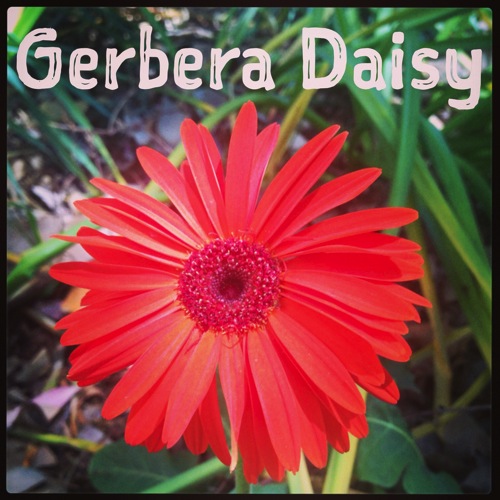Garden Alphabet: Gerbera Daisy
Gerbera Daisy are ubiquitous plants here in Southern California, although usually seen as potted plants given at parties and, in the case of these daisies, as flower for our friend’s memorial service. His wife brought them by afterwards and placed them in the garden as a reminder of him. I wasn’t sure they would even grow directly in the ground, but 3 of the 4 plants I put in have returned each season since. The splash of red is a welcome addition as the blooms and foliage of our paperwhites and snowflakes start to fade at this time of year.

Gerbera
Gerbera (/ˈdʒɜrbərə/ or /ˈɡɜrbərə/) L. is a genus of ornamental plants from the sunflower family (Asteraceae). It was named in honour of the German botanist and naturalist Traugott Gerber († 1743) who travelled extensively in Russia and was a friend of Carolus Linnaeus.[1]
It has approximately 30 species in the wild, extending to South America, Africa and tropical Asia. The first scientific description of a Gerbera was made by J.D. Hooker in Curtis’s Botanical Magazine in 1889 when he described Gerbera jamesonii, a South African species also known as Transvaal daisy or Barberton Daisy. Gerbera is also commonly known as the African Daisy.
Gerbera species bear a large capitulum with striking, two-lipped ray florets in yellow, orange, white, pink or red colours. The capitulum, which has the appearance of a single flower, is actually composed of hundreds of individual flowers. The morphology of the flowers varies depending on their position in the capitulum. The flower heads can be as small as 7 cm (Gerbera mini ‘Harley’) in diameter or up to 12 cm (Gerbera ‘Golden Serena’).
Gerbera is very popular and widely used as a decorative garden plant or as cut flowers. The domesticated cultivars are mostly a result of a cross between Gerbera jamesonii and another South African species Gerbera viridifolia.[2] The cross is known as Gerbera hybrida. Thousands of cultivars exist. They vary greatly in shape and size. Colours include white, yellow, orange, red, and pink. The centre of the flower is sometimes black. Often the same flower can have petals of several different colours.
Gerbera is also important commercially. It is the fifth most used cut flower in the world (after rose, carnation, chrysanthemum, and tulip). It is also used as a model organism in studyingflower formation. Gerbera contains naturally occurring coumarin derivatives. Gerbera is a tender perennial plant. It is attractive to bees, butterflies and/or birds, but resistant to deer.[3]Their soil should be kept moist but not soaked. — Wikipedia
More information on Gerbera:
- Acanthus
- Amaryllis
- Apricot (Prunus armeniaca)
- Azalea
- Banana
- Bonsai
- Bougainvillea
- Brugmansia
- Butterfly (Lepidoptera)
- California Poppy (Eschscholzia californica)
- Calla Lily (Zantedeschia aethiopica)
- Castor Bean (Ricinus)
- Caltapa
- Chives (Allium schoenoprasum)
- Clematis
- Camellia
- Currant (Ribes)
- Dahlia
- Datura
- Japanese Cherry (Prunus serrulata)
- Daffodil (Narcissus)
- Dietes (Fortnight Lily)
- Dudleya
- Echinacea
- Ecualyptus
- Freesia
- Fungi
- Grape (Vitis vinifera)
- Hibiscus (Malvaceae)
- Iris
- Joshua Tree (Yucca brevifolia)
- Kniphofia “Red Hot Poker”
- Lantana
- Lavender (Lavendula)
- Kousa Dogwood (Cornus kousa)
- Magnolia x soulangeana (Saucer Magnolia/Tulip Tree)
- Marigold (Calendula officinalis)
- Matilija Poppy (Romneya)
- Morning Glory (Convolvulaceae)
- Nandina
- Orange
- Orchid from the Southern California Spring Garden Show 2013
- Oriental Poppy (Papaver orientale)
- Polygonatum (Solomon’s Seal)
- Paperwhites
- Pineapple (Ananas comosus)
- Primula (Primrose)
- Queen Anne’s Lace (Daucus carota)
- Rudbeckia
- Salvia
- Squirrel
- Succulents
- Sweet Potato (Ipomoea batatas)
- Tomato
- Water Lily (Nymphaeaceae)
- Wisteria


